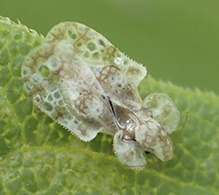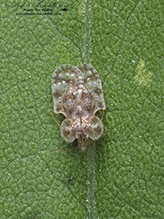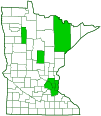chrysanthemum lace bug
(Corythucha marmorata)
Conservation • Description • Habitat • Ecology • Distribution • Taxonomy
Conservation Status |
|
|||||||
| IUCN Red List | not listed |
|||||||
| NatureServe | not listed |
|||||||
| Minnesota | not listed |
|||||||
Description |
||
Chrysanthemum lace bug is a tiny true bug. It occurs throughout the United States and southern Canada and in eastern Asia. In the U.S. it is most common east of the Great Plains and west of the Rocky Mountains. It is one of the most abundant lace bugs in North America. It is not common in Minnesota based on the number of recorded sightings. It is considered a notorious agricultural pest, attacking chrysanthemums and other ornamentals in greenhouses. It also attacks agricultural crops, including sweet potatoes and Jerusalem artichokes. Adults are ⅛″ (3.2 to 3.4 mm) long and 1⁄16″ (1.8 mm) wide. It is one of the smaller lace bugs. The body is black. The upper parts all have a conspicuous network of ridges that creates small cells with milky white rings (areolae) around transparent (hyaline) centers. The head is small and triangular. At the front of the head there is a rounded lobe (tylus) that projects forward. The cheeks (gena) are shorter than the tylus. There are two compound eyes and no simple eyes (ocelli). The antennae are long, slender, yellowish, and covered with bristly hairs. They have four segments. The second segment is very short, and the third segment is longer than the first two. The mouth parts are optimized for piercing and sucking. They take the form of a 4-segmented beak. The exoskeletal plate covering the first segment of the thorax (pronotum) is highly modified. The front of the pronotum is inflated in the middle into a large hood that completely covers and extends slightly forward of the head. The hood is narrowed in front and bulbous behind. There are three longitudinal ridges (carinas). The middle (median) carina is arched, it is higher in front than the lateral carinas, and it has two rows of cells. The lateral carinas are small, low, and short, ending well before the end of the base of the hood. There no dark spots on the paranota. The hood is twice as high as the median carina, and it is not noticeably longer than the middle carina. A triangular, ridged extension in the rear of the pronotum projects backward and covers the small plate between the wing bases (scutellum). A broad, flat, lateral extension (paranotum) on each side of the pronotum projects well beyond the side of the body. The paranota are transparent or lightly tinged yellowish or brownish. The cells on the paranota are slightly smaller than those on the hood. The veins separating the cells are pale or white. The margins of the paranota have a fringe of numerous, small, closely spaced spines. The wing covers (hemelytra) are narrow at the base then abruptly widened for most of their length. The sides of the widened portion are straight, not concave, and are the same width at the base and at the rear. The basal third is slightly elevated. The lateral margins are also armed with a fringe of short spines, but just on the basal half. Smokey brown spots are arranged in four transverse rows. The two rows near the tip are separated by a single row of areolae with transparent centers. The spots in each of these rows are united to form solid bands. The spots are usually well marked, sometimes very faint. The legs are yellowish. |
||
Size |
||
⅛″ (3.2 to 3.4 mm) long |
||
Similar Species |
||
Habitat and Hosts |
||
Mostly plants in the Aster (Asteraceae) family, including Solidago, Aster, Ambrosia, Helianthus, and Rudbeckia, but also plants in at least five other families. |
||
Ecology |
||
Season |
||
Late June to late September (CCESR) |
||
Behavior |
||
Adults are active during the day. Nymphs feed in colonies on the lower side of a leaf. |
||
Life Cycle |
||
|
||
Larva Food |
||
Leaves |
||
Adult Food |
||
|
||
Distribution |
||||
|
Sources |
|||
| 11/1/2022 | ||||
Occurrence |
||||
|
||||
Taxonomy |
|||
Order |
Hemiptera (True bugs, Hoppers, Aphids, and Allies) | ||
Suborder |
Heteroptera (True Bugs) | ||
Infraorder |
Cimicomorpha | ||
Superfamily |
Miroidea | ||
Family |
Tingidae (lace bugs) | ||
Subfamily |
Tinginae | ||
Tribe |
Tingini | ||
Genus |
Corythucha | ||
Synonyms |
|||
Tingis marmorata |
|||
Common Names |
|||
chrysanthemum lace bug |
|||
Glossary
Hemelytron
The forewing of true bugs (order Hemiptera), thickened at the base and membranous at the tip. Plural: hemelytra.
Ocellus
Simple eye; an eye with a single lens. Plural: ocelli.
Pronotum
The exoskeletal plate on the upper side of the first segment of the thorax of an insect.
Scutellum
The exoskeletal plate covering the rearward (posterior) part of the middle segment of the thorax in some insects. In Coleoptera, Hemiptera, and Homoptera, the dorsal, often triangular plate behind the pronotum and between the bases of the front wings. In Diptera, the exoskeletal plate between the abdomen and the thorax.
Visitor Photos |
|||||
Share your photo of this insect. |
|||||
| This button not working for you? Simply email us at info@MinnesotaSeasons.com. Attach one or more photos and, if you like, a caption. |
|||||
Babette Kis |
|||||
Chrysanthemum Lace Bug (Corythucha marmorata) Chrysanthemum Lace Bug (Corythucha marmorata) on a Wild bergamot leaf, Barnes Prairie, Racine Co., WI. Photo taken on July 2, 2021. |
 |
||||
Alfredo Colon |
|||||
 |
|||||
MinnesotaSeasons.com Photos |
|||||
|
|||||

Slideshows |
||

Visitor Videos |
|||
Share your video of this insect. |
|||
| This button not working for you? Simply email us at info@MinnesotaSeasons.com. Attach a video, a YouTube link, or a cloud storage link. |
|||
Other Videos |
|||
| 小刻みに体を揺らすアワダチソウグンバイ Corythucha marmorata(Ⅰ) kiokuima |
|||
About
8/7/2015 2015年8月7日午後、山口県萩市の山間部で撮影しました。サルノコシカケの上を歩行していました。この行動の意味は何なんでしょうか。例えば、フェロモンをまき散らす行動などが、考えられます。このグンバイムシは外来種ということです。 Google Translate: Taken in the mountainous area of Hagi City, Yamaguchi Prefecture, on the afternoon of August 7, 2015. I was walking on the fungus. What is the meaning of this action? For example, behavior such as scattering pheromones is conceivable. This beetle is an alien species. |
|||


Created: 11/1/2022
Last Updated:


